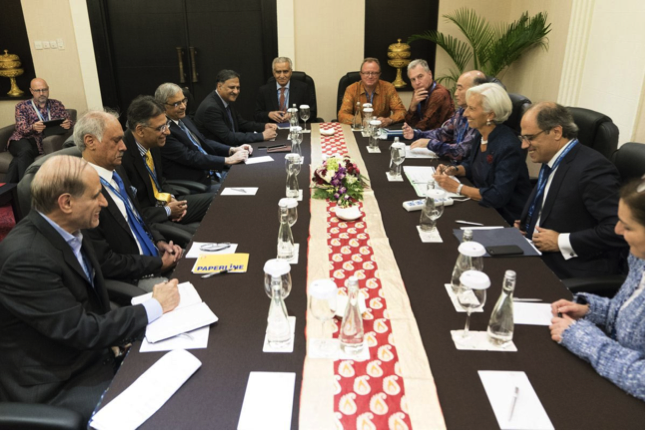THE FUND:

A serious cash and time crunch: Pakistan’s Finance Ministry discusses a bailout package with the IMF’s Christine Lagarde and her team in its first round of talks in October and November. The results were inconclusive. A new round of talks is scheduled for January 2019.
During November, the fund went down 7.1% in SEK as compared to the benchmark MSCI Pakistan Net (SEK)’s return of -6.4%. The Index remained bearish due to a lack of clarity regarding the Balance of Payment crisis and the external funding deficit in the medium term.
In the out-going month, the fund closed out its exposure to Meezan Bank even though it has been a star alpha-contributor and continues to have strong earnings outlook. However, given the ultra-cheap asset valuation in the listed space elsewhere, we feel that in the long-term valuations will have matured and may not be able to sustain the current Price to Book of +2.5x given the increased competition in the Shariah compliant banking space from other conventional banks.
The fund increased its exposure to the power sector, specifically in Hubco Power, which has recently had a change in management and is seeking funds to launch several value-addition projects in the medium-term. Dollar-hedged security coupled with growth-oriented management, should be a strong recipe for above-market returns. Similarly, we increased exposure in Lucky Cement, a blue-chip conglomerate, as it sits tight on substantive cash diversified with an upcoming power project, foreign holdings and stakes in KIA Motors Pakistan and ICI Pakistan. The main under-performing exposures this month were in Consumer Staples and Healthcare, whereas the out-performer was our under-weight stance in the Energy sector.
THE MARKET:
In terms of the market, the situation remains in flux, as we reported in October. Investors continue to sway between hope and uncertainty. Imran Khan’s government has, unfortunately, been unable to clinch a deal with the IMF. For most economic managers and stock investors an agreement with the IMF is the green signal that guarantees clarity over external financing albeit at the cost of high gas and electricity tariffs, steep currency depreciation and a higher discount rate. As a US dollar lender, the IMF has enacted these policies to ensure smooth repayment in dollars. Unsurprisingly the IMF’s demands were not well-received domestically and Asad Umar, Finance Minister, fears a popular backlash. With this in mind, while Asad Umar has repeatedly said that the IMF remains the preferred lender of choice and a deal is likely to conclude by mid-January, he is simultaneously exploring alternative options to the IMF.
In the short-term, (read, immediate), the Balance of Payment crisis is over. The government is covered by a USD 3bn oil credit facility and USD 3bn deposits from Saudi Arabia, in addition to an undisclosed, but most likely similar, amount from China. Please note, China has already lent to Pakistan on several occasions over the last few years, more so than the IMF.
On the economic front, the Central Bank of Pakistan increased the discount rate by 150bps entering double-digit territory (as demanded by the IMF). The currency closed PKR 137 against the US dollar despite wild intra-day swings. The result of a cumulative 30% depreciation and 425bps tightening has not been reflected in the trade balance that still remains sticky. The Current Account Deficit for October USD 1.2bn (annualised 4%) – the YoY decline of 1% in imports and 1% YoY growth in exports does not get Pakistan in the green zone yet. However, the massive depreciation (7%) in October, coupled with ~30% decline in oil prices should most definitely improve the Current Account Deficit numbers in the next 2-3 months. The Real Effective Exchange Rate (REER) has come down from 127 in April 2017 to a latest reading of 108. The Finance Minister has given regionally competitive gas and electricity rates to exporters. These measures, we hope, will be enough to see a structural improvement from low-base exports at this time.
November also saw two blue-chip names being removed from the MSCI Emerging Market Index – UBL and Lucky Cement – causing a cumulative $100m foreign outflow in the month. Passive outflows were bought by local insurance companies, high net worth individuals, and foreign investors.
Going forward, we believe that the implementation of the FATF’s recommendations, an improved relationship with the US, and its subsequent leniency (or lack thereof) during IMF discussions will guide the market forward. A steep rise in the discount rate should see a shifting of asset class from equity to fixed-income securities locally, thereby keeping the cyclical sector pushed to unsustainable ultra-cheap asset valuation. Broader KSE-100 Index trades at a 1-year forward P/E of 7.8x are likely to remain range-bound, in the very short run, until a deal is finalised with the IMF.
DISCLAIMER:
Capital invested in a fund may either increase or decrease in value and it is not certain that you will be able to recover all of your investment. Historical return is no guarantee of future return. The Full Prospectus, KIID etc. are available on our homepage. You can also contact us to receive the documents free of charge. Please contact us if you require any further information: +46 8-5511 4570.
Kundgrupp / Investortype:
* Ontario and Quebec